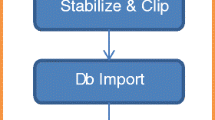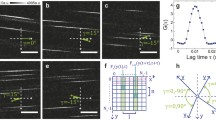Abstract
The blood vessel diameter is often measured in microcirculation studies to quantify the effects of various stimuli. Intravital video microscopy is used to measure the change in vessel diameter by first recording the video and analyzing it using electronic calipers or by using image shearing technique. Manual measurement using electronic calipers or image shearing is time-consuming and prone to measurement error, and automated measurement can serve as an alternative that is faster and more reliable. In this paper, a new feature-based tracking algorithm is presented for automatically measuring diameter of vessels in intravital video microscopy image sequences. Our method tracks the vessel diameter throughout the entire image sequence once the diameter is marked in the first image. The parameters were calibrated using the intravital videos with manual ground truth measurements. The expriment with 10 synthetic videos and 20 intravital microscopy videos, including 10 fluorescence confocal and 10 non-confocal transmission, shows that the measurement can be performed accurately.
















Similar content being viewed by others
References
L. G. Brown. A survey of image registration techniques. ACM Computing Surveys, 24(4):325–376, 1992.
R. W. Cox and A. Jesmanowicz. Real-Time 3D Image Registration for Functional MRI. Magnetic Resonance in Medicine, 42:1014–1018, 1999.
C. Davatzikos, J. L. Prince, and R. N. Bryan. Image registration based on boundary mapping. Medical Imaging, IEEE Transactions on, 15(1):112–115, 1996.
T. Duza and I. H. Sarelius. Increase in endothelial cell Ca2+ in response to mouse cremaster muscle contraction. The Journal of Physiology, 555(2):459–469, 2004.
F. N. E. Gavins and B. E. Chatterjee. Intravital micro-scopy for the study of mouse microcirculation in anti-inflammatory drug research: focus on the mesentery and cremaster preparations. J. Pharmacological and Toxicological Methods, 49:1–14, 2004.
A. Giachetti. Matching techniques to compute image motion. Image and Vision Computing, 18:247–260, 2000.
Intaglietta, M., and K. Messmer. Technological Developments in the Study of the Microcirculation. Clinical and Applied Microcirculation Research. Boca Raton: CRC Press, pp. 139–148, 1995.
J. F. Krucker, G. L. LeCarpentier, J. B. Fowlkes, and P. L. Carson. Rapid elastic image registration for 3-D ultrasound. Medical Imaging, IEEE Transactions on, 21(11):1384–1394, 2002.
F. Maes, A. Collignon, D. Vandermeulen, G. Marchal, and P. Suetens. Multimodality image registration by maximization of mutualinformation. Medical Imaging, IEEE Transactions on, 16(2):187–198, 1997.
S. Magers and J. E. Faber. Real-time measurement of microvascular dimensions using digital cross-correlation image processing. Journal of Vascular Research, 29:241–247, 1992.
J. A. Maintz and M. A. Viergever. A survey of medical image registration. Medical Image Analysis, 2(1):1–36, 1998.
C. L. Murrant and I. H. Sarelius. Local and remote arteriolar dilations initiated by skeletal muscle contraction. Am. J. Physiol. Heart Circ. Physiol., 279:H2285–H2294, 2000.
J. W. Pluim, J. A. Maintz, and M. A. Viergever. Image registration by maximization of combined mutual information and gradient information. Medical Imaging, IEEE Transactions on, 19(8):809–814, 2000.
Schmugge, S., W. Kamoun, J. Villalobos, M. Clemens, and M. Shin. Segmentation of vasculature for intravital microscopy using bridging vessel snake. In: IEEE International Symposium on Biomedical Imaging, 2006, pp. 177–180
M. Sonka, W. Liang, and R. M. Lauer. Automated analysis of brachial ultrasound image sequences: early detection of cardiovascular disease via surrogates of endothelial function. IEEE Transactions on Medical Imaging, 21(10):1271–1279, 2002.
K. Tyml, D. Anderson, D. Lidington, and H. Lakak. A new method for assessing arteriolar diameter and hemodynamic resistance using image analysis of vessel lumen. American Journal of Physiology - Heart and Circulatory Physiology, 284:1721–1728, 2003.
Acknowledgment
This work was supported in part by Grant No. HL18208 and HL76414 from National Institute of Health.
Author information
Authors and Affiliations
Corresponding author
Rights and permissions
About this article
Cite this article
Lee, J., Jirapatnakul, A.C., Reeves, A.P. et al. Vessel Diameter Measurement from Intravital Microscopy. Ann Biomed Eng 37, 913–926 (2009). https://doi.org/10.1007/s10439-009-9666-5
Received:
Accepted:
Published:
Issue Date:
DOI: https://doi.org/10.1007/s10439-009-9666-5




